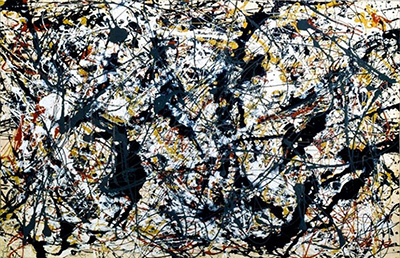Jackson Pollock was one of the key contributors to abstract expressionism - and, indeed, to modern art as a whole. His chaotic compositions of shapeless splashes freed colour and feeling from any sort of coherent form, paving the way for a later generation of liberated modern artists.
To see a Jackson Pollock canvas is to be confronted by beauty in meaninglessness: a viewer who gazes into the scattered shapes will soon find patterns and images forming in their heads as their minds try to make sense of the unfamiliar mass before them.
Pollock's art must surely constitute some of the purest and rawest ever painted, as it communicates directly with the viewer on a deep, primal level. Once a person has experienced the art of Jackson Pollock, they will never forget the effect it had on them.
Silver over Black, White, Yellow and Red is a classic example of a Pollock work. As its name suggests, it restrains itself to just five colours - only two of which, yellow and red, are true colours.
Amidst the cacophony of strands and splashes the viewer's eye is immediately drawn to a cluster of larger black shapes.
These are simply random formations of paint, but the human mind will inevitably try to interpret them as familiar shapes: as shadows of human figures, perhaps, or as black birds in flight. But more importantly, the painting provokes emotions.
This is how abstract expressionism functions, the main genius of the movement: it builds feeling and reaction out of sheer meaninglessness. Anybody who buys a print of Jackson Pollock's Black, White, Yellow and Red will find the room completely transformed by this new source of emotion.




